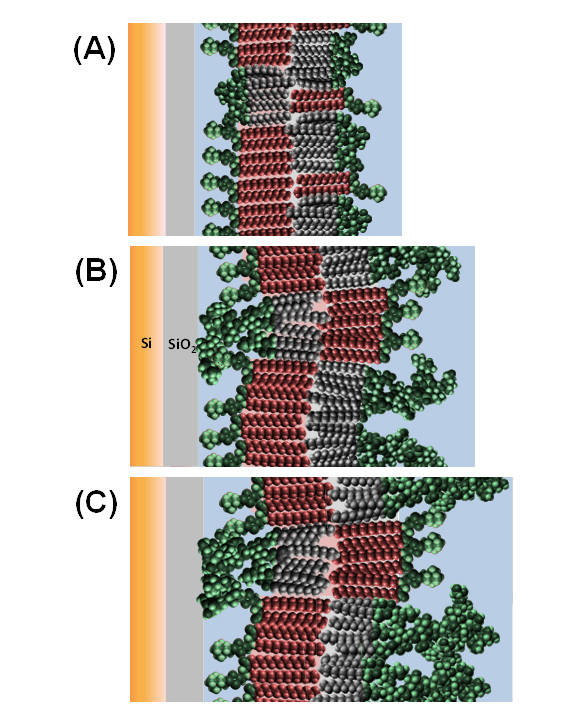Luckily these strains are harmless, however, their “sister” strains such as the tongue twisting enterohaemorrhagic Escherichia coli (EHEC) have been responsible for fatal outbreaks of food poisoning and other strains can lead to meningitis and septicaemia. E.coli are part of a group of bacteria called gram negative which have a characteristic outer lipid membrane. This membrane acts as a barrier to antibiotics and is of scientific interest as many different gram negative bacteria are becoming an increasing threat to us due to their antibiotic resistance. In the hope to unlock more about this outer membrane and its dynamics a team of scientists from ISIS, Newcastle University and the Bragg Institute in Australia have assembled membranes that mimic the gram negative bacterial outer membrane and could be used in the future to study physical interactions with it.
Scientists have emulated the gram negative bacterial outer membrane creating a model for future study.
Dr Luke Clifton, ISIS scientist, says “We have been looking at the outer membranes of gram negative bacteria such as E.coli. These membranes are useful in many biotechnological processes such as making insulin but are also of biomedical interest because of they act as a barrier to antibiotics and antimicrobial peptides due to their thick lipopolysaccharide outer leaflet.”
The problem is these bacteria are tiny so looking at the outer membrane dynamics and interactions of antibiotics with the bacteria has proved difficult. However the team have come up with a physical model of the membrane providing a platform for future study.
Getting the symmetry straight
Unlike the inner membrane, the Gram negative bacterial outer membrane is asymmetric in terms of its lipid components, consisting of a phospholipid rich inner leaflet and a lipopolysaccharide (LPS) rich outer leaflet.
Luke explains, “The membrane predominantly contains two types of lipid molecules, phospholipids and lipopolysaccharides, these are what we call amphiphiles; they have a hydrophilic or water loving region and a hydrophobic or water repelling region. Due to their amphiphilic nature these self-assemble to form bilayers or membranes.”
Lipopolysaccharides have a very large hydrophilic region composed of a chain of polysaccharides. This chain forms a thick layer on the external surface of the bacteria protecting it from attack by hydrophobic antibiotics.
It’s all in the design.
The team constructed the membrane by depositing phospholipids onto a silicon crystal after which they then deposited the lipopolysaccharides.
Luke explains, “We constructed the membranes by depositing an inner leaflet of the phospholipids onto a silicon crystal using a technique called Langmuir-Blodgett deposition. We then deposited the lipopolysaccharides that had been extracted from forms of E.coli, using Langmuir –Schaefer deposition, to form the outer leaflet.”
Neutron reflectometry is particularly good at looking at the structure of biological membranes and the interactions with these. The team used this technique to see how closely the structure modelled the actual bacterial membrane and to examine the coverage and mixing of lipids between the bilayer leaflets. They used different isotopes of hydrogen to label the lipids in order to get a contrast between the phospholipids and lipopolysaccharides with neutrons.
Luke explains “We used isotopic contrast labelling in order to be able to examine the asymmetry of our model membranes. We used deuterated phospholipids and hydrogenated lipopolysaccharides. Neutrons interact very differently with deuterium and hydrogen; this gave us a data showing a high contrast between the two lipids and allowed us to determine the relative contribution of the membrane components to the inner leaflet and outer leaflet.”

A cartoon representation of the membrane structure; Phospholipid tails (red) and the lipopolysaccharide tails (grey). Where (A) Phospholipid:lipid A, (B) Phospholipid: Rc-LPS and (C) Phospholipid: Ra-LPS.
View full-size image
Going the distance
Because of the large solubility of the LPS the task of forming bilayers has proven problematic when using the full length of the LPS however the team constructed membranes using three different lengths of LPS. They managed to form stable bilayers from all three types generating increasingly realistic membrane models as they increased length of the LPS.
Luke explains “Lipopolysaccharide consists of lipid A, which is the hydrophobic component which anchors the LPS to the outer membrane, attached to this is the core polysaccharide region and then the O antigen polysaccharide chain. We have used LPS of varying sizes and complexity, from just lipid A to those containing the entire core oligosaccharide region and we have been able to produce stable membranes in all cases that make good models for the gram-negative membrane.
Felice Laake
Luke Clifton et al.
Research date: October 2013
Further Information
This research has been published in the Royal Society Journal Interface.
For further information please contact Dr Luke Clifton
